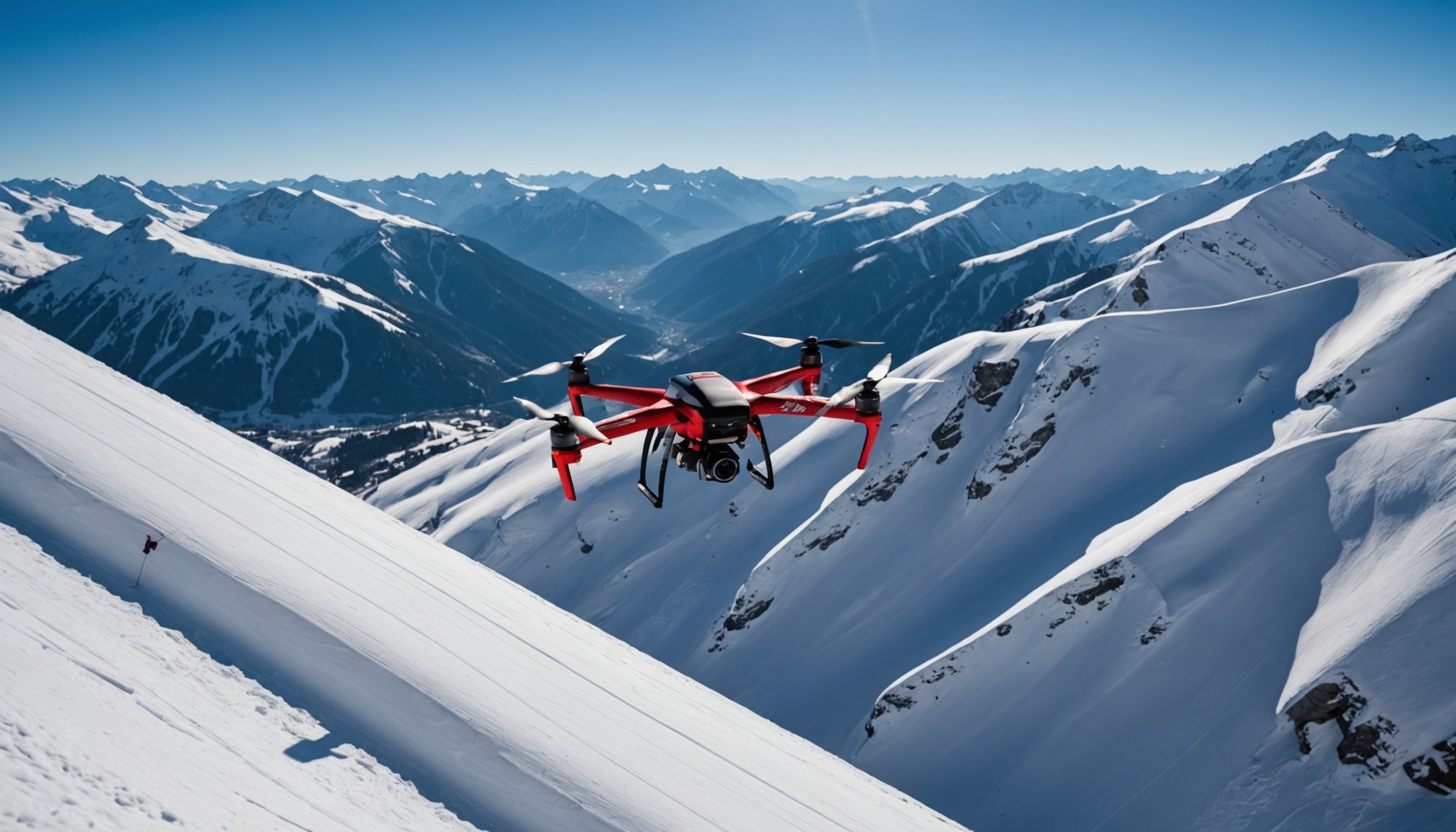Soaring to Safety: How Drone Innovations are Transforming Surveillance in Alpine Ski Racing
The Evolution of Alpine Skiing Safety
Alpine skiing, a sport that thrills and challenges athletes and spectators alike, has always been at the forefront of innovation when it comes to safety. From the advanced helmets like the Bolle Brand Adult Snow Helmet featuring MIPS Technology, to the stringent rules governed by the FIS (Fédération Internationale de Ski), safety has been a paramount concern[1][3].
In recent years, a new player has entered the scene to enhance safety and performance in alpine skiing: drones. These aerial vehicles, equipped with cutting-edge technology, are revolutionizing the way we approach surveillance, data collection, and decision making in the world of alpine ski racing.
Topic to read : Revealing sports excellence: how genetic profiling personalizes elite training regimens
The Role of Drones in Alpine Ski Racing
Drones are no longer just a novelty; they have become an integral part of various industries, including sports. In alpine skiing, drones are used for several critical functions:
Real-Time Data Collection
Drones equipped with high-resolution cameras and sensors can capture real-time data on the ski slopes. This data includes information on snow conditions, weather patterns, and even the performance of skiers. For instance, during the World Cup events, drones can provide live footage and data that help in assessing the condition of the slalom course or giant slalom tracks, ensuring that the competition is held under safe and optimal conditions.
Also to read : Maximize athletic potential: how continuous glucose monitoring empowers diabetic athletes
Enhanced Surveillance
In the wake of incidents like the fatal landslide on the RD530 in Oisans, France, where a passenger died due to an avalanche, the use of drones for surveillance has become more crucial. Drones can conduct daily drone checks of the area, providing real-time updates on potential hazards such as avalanches or rockfalls. This ensures that the ski slopes are safe for athletes and spectators alike[4].
Motion Capture and Performance Analysis
Drones can be used to capture the motion of alpine skiers in detail, providing valuable insights into their technique and performance. This is particularly useful for coaches and athletes looking to improve their ski turns and overall racing strategy. By analyzing the data collected by drones, skiers can refine their turn phases, ground reaction, and other critical aspects of their performance.
Technology Behind Drone Innovations
The technology driving these drone innovations is multifaceted and sophisticated.
Artificial Intelligence and Machine Learning
Drones are increasingly being integrated with artificial intelligence (AI) and machine learning (ML) algorithms. These technologies enable drones to analyze vast amounts of data in real time, making them more efficient and accurate in their surveillance and data collection tasks. For example, AI can help drones detect anomalies in snow patterns or weather conditions that might pose a risk to skiers.
Sensor-Based Systems
Drones are equipped with a variety of sensors, including GPS, accelerometers, and cameras. These sensors provide a comprehensive view of the ski environment, allowing for precise monitoring and analysis. In the context of alpine skiing, sensor-based systems can help in earth observation, tracking changes in the terrain, and predicting potential hazards.
High-Resolution Imaging
High-resolution imaging capabilities of drones allow for detailed analysis of the ski slopes. This is particularly useful for course preparation and maintenance. For instance, drones can identify areas where the snow is too thin or where there are obstacles that need to be cleared before a race.
Practical Applications and Examples
The use of drones in alpine ski racing is not just theoretical; it has several practical applications that are already being implemented.
World Cup Events
During World Cup events, drones are used to provide live coverage and real-time data. For example, during the moguls event in Bakuriani, Georgia, drones could have been used to monitor the condition of the moguls and provide insights into the performance of athletes like Mikaël Kingsbury and Benjamin Cavet[2].
Climate Change Monitoring
Drones can also be used to monitor the impact of climate change on ski slopes. By tracking changes in snow cover, temperature, and other environmental factors, drones can help ski resorts and governing bodies make informed decisions about how to adapt to these changes.
Table: Comparison of Traditional and Drone-Based Surveillance in Alpine Skiing
| Feature | Traditional Surveillance | Drone-Based Surveillance |
|---|---|---|
| Real-Time Data | Limited | High-resolution, real-time data |
| Coverage Area | Limited to fixed cameras | Extensive coverage with aerial view |
| Cost | High (multiple cameras, personnel) | Lower (single drone, minimal personnel) |
| Accuracy | Dependent on camera placement | High accuracy with sensor-based systems |
| Flexibility | Fixed positions | Dynamic, can be moved as needed |
| Environmental Monitoring | Limited | Comprehensive monitoring of snow and weather conditions |
| Performance Analysis | Limited to human observation | Detailed motion capture and analysis |
Quotes from Experts
- “Drones have revolutionized the way we monitor and prepare ski slopes. The real-time data they provide is invaluable for ensuring safety and optimizing performance,” says a spokesperson from the FIS.
- “Using drones for surveillance and data collection has been a game-changer. It allows us to make more informed decisions and provide a safer environment for our athletes,” notes a coach from the Canadian alpine ski team.
Future of Drone Innovations in Alpine Skiing
As technology continues to advance, the role of drones in alpine skiing is expected to expand further.
Project Aims and Research
Several projects are underway to explore the full potential of drones in alpine skiing. For instance, research is being conducted on how drones can be integrated with other technologies like GPS and wearable sensors to provide a more comprehensive view of an athlete’s performance. These projects aim to enhance safety, improve performance, and make the sport more accessible.
Services and Integration
Drones are likely to become an integral part of the services offered by ski resorts and racing organizations. This could include drone-based ski lessons, where instructors use drones to provide real-time feedback to skiers, and drone-assisted course preparation, where drones help in maintaining the optimal condition of the slopes.
The integration of drones into alpine ski racing is a significant step forward in terms of safety, performance analysis, and environmental monitoring. As this technology continues to evolve, we can expect even more innovative applications that will transform the sport in meaningful ways.
For alpine skiers, coaches, and fans, the future looks promising. With drones soaring above the slopes, capturing data and providing insights, the world of alpine skiing is set to become safer, more efficient, and more thrilling than ever before.
Practical Insights and Actionable Advice
- Invest in Drone Technology: For ski resorts and racing organizations, investing in drone technology can provide a significant edge in terms of safety and performance.
- Train Personnel: Ensure that personnel are trained to use drones effectively and safely.
- Integrate with Other Technologies: Combine drone data with other technologies like GPS and wearable sensors to get a comprehensive view of athlete performance.
- Monitor Climate Change: Use drones to track the impact of climate change on ski slopes and make informed decisions about adaptation strategies.
By embracing these innovations, we can ensure that alpine skiing continues to thrive as a safe and exhilarating sport for generations to come.











